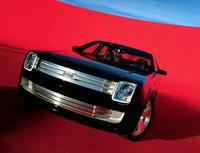Giving Concept Cars A Longer Life
By Michael Collins, FCN
 |
Had it not been for a Lincoln design team's vision of the future, who knows what Batman might have driven in the '60s. The vehicle that became famous as television's Batmobile started out as the Lincoln Futura, a concept car that debuted at the Chicago Auto Show in 1955.
Called "Dream Cars" and "Idea Cars," concept cars are chiefly designed to create buzz and attract crowds. Some are fully functioning vehicles with drivetrains borrowed from production models. Others are simply mock-ups, pieced together with any combination of glue, plastic, metal or fiberglass.
"Concept vehicles do a great job of generating positive media coverage and helping to build the Ford brand image," said Tim Boyd, director of business development for Ford Global Design. "But even more, they are a means of product strategy and design exploration."
As an example, Boyd points to the Ford 427 concept that debuted in 2003.
"It was a creative process that generated the whole three-bar grill design element. It helped make the Fusion such a success that we're rolling it out on many vehicles throughout the Ford lineup in North America," he said.
 |
The three-bar grill was also a part of the Ford F-250 Super Chief concept that debuted at the Detroit Auto Show in January. According to design director Pat Schiavone, the entire process took 18 months.
"Before we even began a sketch, we had to create a story," he said.
For the Super Chief, the team set out to answer the questions, how luxurious can a truck be and at the same time, how efficient can it be?
The end result was an elegant glass-roofed vehicle with the world's first Tri-Flex engine enabling the supercharged V-10 to run for 500 miles between fill ups on hydrogen, E85 ethanol or gasoline.
The interior featured premium amenities that included walnut, brushed aluminum, leather and ottomans, that deployed from the floor space.
Not only does the Super Chief's styling turn heads, the engine, which operates on three fuels, is capable of speeds in excess of 95 mph.
Schiavone expects the Super Chief to be on the auto show circuit for the next two to three years. But when it's not touring he plans on bringing it back to the design studio in Dearborn as a kind of mechanical muse that can influence future designs.
"We're going to be pulling the Super Chief in for the design of every truck we do for the next couple of years," he said. "We don't want to lose what we did there."
But once the Super Chiefs mission is complete what will happen to the elegant behemoth?
The ultimate fate of concept cars over the years has varied, from ending up in collections to being crushed. Unlike the Lincoln Futura that hit the Hollywood "big time," many of the older vehicles have been destroyed, according to John Biel, editor-in-chief of Collectable Automobile magazine.
"You have to remember in the context of a day-to-day environment they didn't always see everything as timeless," he said. "The vehicle served its purpose and they moved on."
Other reasons for trashing those early concepts included maintenance costs and legal concerns.
"Most of them didn't meet any highway requirements or specifications so they were destroyed on the advice or lawyers," said Joe Bortz, a Chicago businessman who claims to own the largest collection of '50s and '60s concept cars in the world. "They wanted to protect themselves from any legal problems that might come up if the vehicle got into public hands."
But while some companies may have let their concept vehicles disappear, Ford Motor Company held on to many of its classics until 2002 when it held a first-of-a-kind auction of 51 prototypes that raised $4,365,968 for the Ford Motor Company Fund.
"I think that approach is a lot better then letting them collect dust," said David Woodhouse, the design director at Ford's Premier Automotive Group in Irvine, Cal. "Let's let people refit them to work properly and take them out to some of these classic car shows.
"The auction was a great idea," said Boyd. "By going to the collector community, those vehicles will be loved, cherished and shared, plus we raised money for the Ford Fund. It was a win-win."



